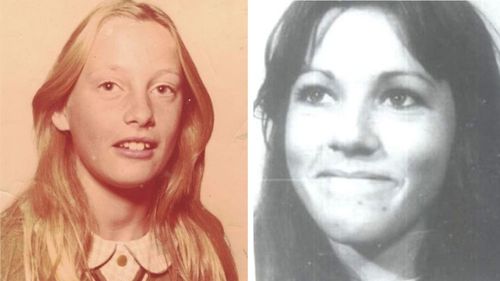<div class="block-content"><div class="styles__Container-sc-1ylecsg-0 goULFa"><span>A new podcast investigating the disappearance of two teenage girls from the NSW Sutherland Shire more than 40 years ago has revealed striking similarities in the cold case to other unsolved murders in the region.</span></div></div><div class="block-content"><div class="styles__Container-sc-1ylecsg-0 goULFa"><span>When good friends Elaine Johnson, 16, and Kerry Anne Joel, 17, vanished in January 1980, the police cast the pair as runaways.</span></div></div><div class="block-content"><div class="styles__Container-sc-1ylecsg-0 goULFa"><span>The girls were seen as rebellious because Elaine left home shortly after arguing with her parents over a party held at their house, and Kerry Anne had a minor accident in her mother's car.</span></div></div><div><div id="adspot-mobile-medium"></div></div><div class="block-content"><div class="styles__Container-sc-1ylecsg-0 goULFa"><span>However, Elaine's family has maintained she wasn't the type to run away and never gave up searching for answers.</span></div></div><div class="block-content"><div class="styles__Container-sc-1ylecsg-0 goULFa"><strong><span>READ MORE:</span></strong><span> </span><a href="https://www.9news.com.au/national/elaine-johnson-podcast-casts-doubt-on-police-investigation-into-teen-girls-who-vanished-45-years-ago/a8d122ca-8f27-4f92-ad34-6f75c6e6727c" rel="" target="" title="A wild party broke out at Elaine's house. Weeks later, she vanished"><strong><span>A wild party broke out at Elaine's house. Weeks later, she vanished</span></strong></a></div></div><div class="block-content"><div class="styles__Container-sc-1ylecsg-0 goULFa"><span>Key police shortcomings in their case have been examined in the investigative podcast </span><a href="https://podcasts.apple.com/us/podcast/out-from-the-cold-searching-for-elaine/id1840856418" rel="" target="" title="Out from the Cold: Searching for Elaine"><em><span>Out from the Cold: Searching for Elaine</span></em></a><span>.</span></div></div><div class="block-content"><div class="styles__Container-sc-1ylecsg-0 goULFa"><span>The girls' friends weren't interviewed until more than three decades later, in 2014, and, at an inquest in 2016, it was revealed Elaine's original police file had been lost.</span></div></div><div><div class="OUTBRAIN" data-reactroot="" data-src="//www.9news.com.au/national/cold-case-connections-months-before-elaine-and-kerry-ann-vanished-two-other-girls-went-missing/e69ff0a6-726c-429b-8e8d-ade06d076a56" data-widget-id="AR_5"></div></div><div class="block-content"><div class="styles__Container-sc-1ylecsg-0 goULFa"><span>Elaine and Kerry Anne weren't the only teenage girls to go missing from the NSW south coast around that time, and for the subsequent police investigation to be riddled with incompetence. </span></div></div><div class="block-content"><div class="styles__Container-sc-1ylecsg-0 goULFa"><span>Just seven months earlier, in July 1979, 16-year-old Kay Docherty and 15-year-old Toni Kavanagh went missing from Warilla, a suburb on the outskirts of Wollongong.</span></div></div><div class="block-content"><div class="styles__Container-sc-1ylecsg-0 goULFa"><span>The high school students were last seen at a Warilla bus stop. They had planned to hitchhike to Wollongong to go to a disco.</span></div></div><div class="block-content"><div class="styles__Container-sc-1ylecsg-0 goULFa"><span>An inquest in 2013 found the girls had likely died shortly after they went missing and aired suspicions of detectives that they may have been murdered by notorious Australian serial killer Ivan Milat.</span></div></div><div class="block-content"><div class="styles__Container-sc-1ylecsg-0 goULFa"><span>"They went without telling anyone. Kay told her parents she was staying at Toni's house for the night, and Toni told her family she and Kay were going to the movies," Jeff Dakers, a retired NSW police officer who was one of the first to investigate Kay and Toni's disappearances, told the podcast.</span></div></div><div class="block-content"><div class="styles__Container-sc-1ylecsg-0 goULFa"><span>With very few leads to go on, the girls just became missing people, Dakers said.</span></div></div><div class="block-content"><div class="styles__Container-sc-1ylecsg-0 goULFa"><span>About a decade ago, Dakers was contacted by local police officers who wanted to chat about the case.</span></div></div><div class="block-content"><div class="styles__Container-sc-1ylecsg-0 goULFa"><span>To his shock, Dakers was told the files on Kay and Toni's disappearance had been misplaced and police had no evidence to go on.</span></div></div><div class="block-content"><div class="styles__Container-sc-1ylecsg-0 goULFa"><span>Dakers also told of a chilling conversation he had with a Warilla local man who used to ride his bike in the sand dunes as a boy in 1980.</span></div></div><div class="block-content"><div class="styles__Container-sc-1ylecsg-0 goULFa"><span>In the podcast the local man is referred to as Liam. Liam recalled seeing a man with two girls in the sand dunes in 1980, who told him the man was trying to kill them.</span></div></div><div class="block-content"><div class="styles__Container-sc-1ylecsg-0 goULFa"><span>Dakers said Liam told him the girls he saw that day managed to escape the man and run to a local house.</span></div></div><div class="block-content"><div class="styles__Container-sc-1ylecsg-0 goULFa"><span>Not long after, Liam went back to the sand dunes and saw the same man with a shovel and a ute.</span></div></div><div class="block-content"><div class="styles__Container-sc-1ylecsg-0 goULFa"><span>The retired copper said Liam told him he believed the man he saw those two times out riding his bike was notorious Milat.</span></div></div><div class="block-content"><div class="styles__Container-sc-1ylecsg-0 goULFa"><span>Liam says he had only recognised the man as Milat years later after seeing him in a documentary.</span></div></div><div class="block-content"><div class="styles__Container-sc-1ylecsg-0 goULFa"><span>Milat was convicted in 1996 of the murders of seven backpackers whose bodies were found in the Belanglo State Forest, in the NSW southern highlands.</span></div></div><div class="block-content"><div class="styles__Container-sc-1ylecsg-0 goULFa"><span>He was sentenced to life in prison and died in jail in 2019.</span></div></div><div class="block-content"><div class="styles__Container-sc-1ylecsg-0 goULFa"><span>Milat's victims were all killed between 1989 and 1992 after he picked them up hitchhiking.</span></div></div><div class="block-content"><div class="styles__Container-sc-1ylecsg-0 goULFa"><span>Police have long suspected that more victims of Milat are yet to be uncovered.</span></div></div><div class="block-content"><div class="styles__Container-sc-1ylecsg-0 goULFa"><span>In 1993, Task Force Air reviewed nationwide unsolved cases of murdered and missing young people who could be possible Milat victims and the list ran to 58 people.</span></div></div><div class="block-content"><div class="styles__Container-sc-1ylecsg-0 goULFa"><span>Last month, a NSW parliamentary inquiry into missing person cases and unsolved murders was announced.</span></div></div><div class="block-content"><div class="styles__Container-sc-1ylecsg-0 goULFa"><span>The inquiry will focus on cases from 1965 to 2010, and investigate possible links between unsolved murders and long-term missing people around the Southern Highlands, Inner Sydney, Newcastle and the North Coast.</span></div></div><div class="block-content"><div class="styles__Container-sc-1ylecsg-0 goULFa"><span>Toni and Kay's disappearance will be one of several case studies examined for possible systematic failings in the criminal justice system, and with a view to how new technology can assist police.</span></div></div><div class="block-content"><div class="styles__Container-sc-1ylecsg-0 goULFa"><span>The push for the inquiry came from NSW upper house member Jeremy Buckingham, who gained support from Premier Chris Minns. </span></div></div><div class="block-content"><div class="styles__Container-sc-1ylecsg-0 goULFa"><span>Buckingham told the Illawarra Mercury there were often failings by the police during the era when Toni and Kay went missing.</span></div></div><div class="block-content"><div class="styles__Container-sc-1ylecsg-0 goULFa"><span>In the 1970s and 80s, Buckingham said, women and girls who went missing or were murdered were often considered runaways or at fault for being out at night and "making themselves vulnerable" by catching a bus alone or hitchhiking.</span></div></div><div class="block-content"><div class="styles__Container-sc-1ylecsg-0 goULFa"><span>"Now, it's utterly egregious to think like that," he said.</span></div></div><div class="block-content"><div class="styles__Container-sc-1ylecsg-0 goULFa"><span>A lack of urgency led cases to go cold quickly, Buckingham added.</span></div></div><div class="block-content"><div class="styles__Container-sc-1ylecsg-0 goULFa"><span>"Key people weren't interviewed, and I don't think it's an isolated incident," he said.</span></div></div><div class="block-content"><div class="styles__Container-sc-1ylecsg-0 goULFa"><span>"How it is that two young women, two girls can just disappear off a suburban street, and key family members are not interviewed for years, if not decades, later."</span></div></div>
Months before Elaine and Kerry Anne vanished, two other girls went missing

Leave A Reply
Your email address will not be published.*